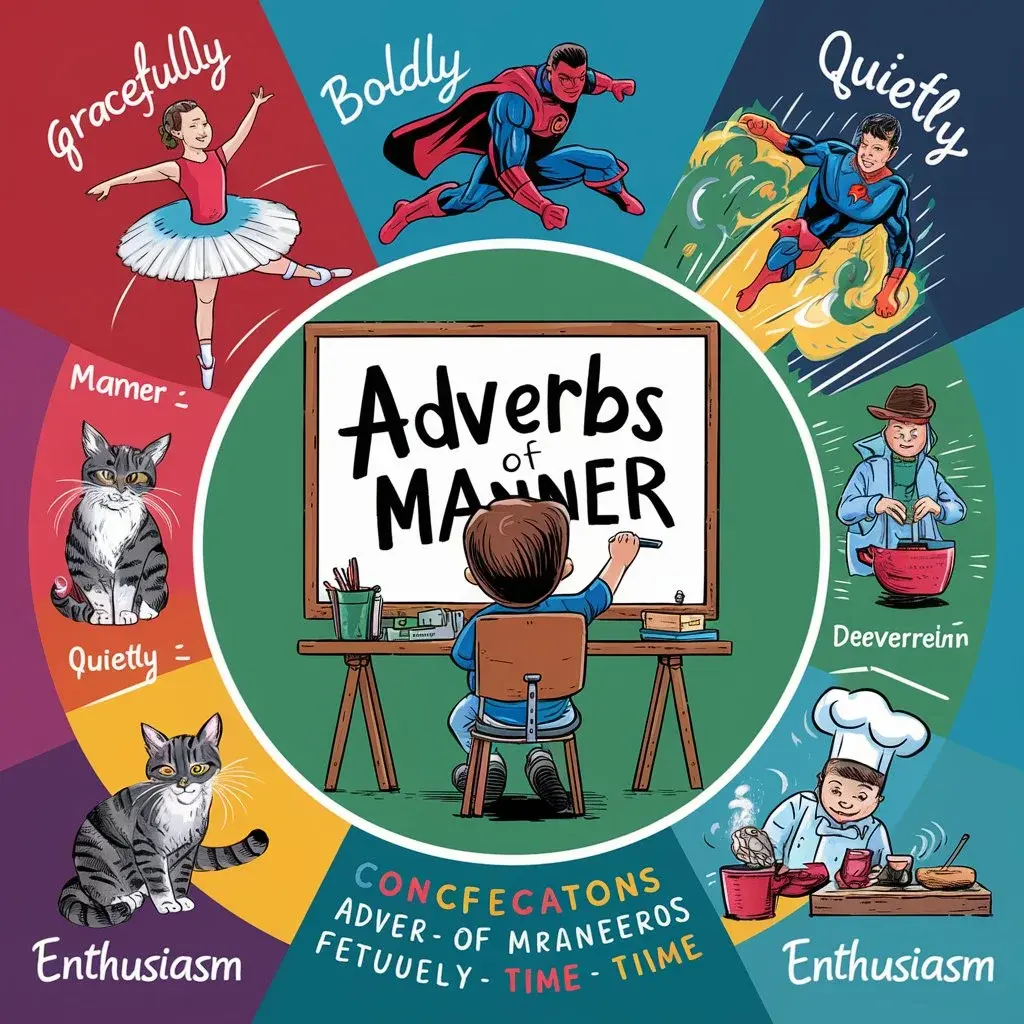Adverbs of manner are the secret ingredient to making your writing and speech more descriptive, engaging, and precise. Have you ever felt your sentences lacked a certain vividness or clarity? These adverbs describe how an action is performed, adding depth and detail that transform simple sentences into captivating narratives.
Whether you’re writing a story, giving a speech, or just having a conversation, adverbs of manners help you convey the method, style, or intensity of actions more effectively. Let’s explore how these powerful words can enhance your English communication.
Let’s discover the magic of adverbs of manners and learn the skills to use them effectively in everyday conversation.
What Are Adverbs of Manner?
Adverbs of manners are the adverbs that describe how an action is performed or the way in which something happens. They provide additional information about the verb in a sentence, answering the question of “how” the action is carried out. Let’s dive into some examples:
- She sings beautifully.
- He speaks loudly.
- They danced gracefully.
In each of these sentences, the adverbs of manners (beautifully, loudly, gracefully) enhance our understanding of how the actions are carried out. Without them, our sentences would be quite bland, right?
Adverbs of Manner Examples
Let’s take a look at some adverbs of manner examples:
- She danced gracefully.
- He spoke softly to the baby.
- They ran quickly to catch the bus.
- The chef cooked the meal perfectly.
- She sang beautifully at the concert.
- He drives carefully in the rain.
- They celebrated their win happily.
- The dog barked loudly at the stranger.
- She worked diligently on her project.
- He answered the question confidently.
- The teacher explained the lesson clearly.
- She smiled warmly at the guests.
- He completed the assignment efficiently.
- They played the game enthusiastically.
- She walked slowly down the aisle.
- The child drew the picture neatly.
- He listened to the instructions attentively.
- They laughed heartily at the joke.
- She whispered secretly to her friend.
- He repaired the car skillfully.
- The cat moved silently through the house.
- She answered the phone politely.
- He finished the race exhaustedly.
- They cheered for their team excitedly.
- She looked at the painting curiously.
- He waited patiently for his turn.
- They discussed the topic seriously.
- She performed the dance elegantly.
- He argued his point passionately.
- They hugged each other tightly.
You can use these adverbs to paint a clearer picture of actions in your sentences. Are you starting to see how adverbs of manners work?
List of Adverbs of Manner
Here’s the list of adverbs of manner in English:
| Adverb | Adverb |
| Quickly | Slowly |
| Carefully | Loudly |
| Quietly | Cautiously |
| Happily | Sadly |
| Silently | Noisily |
| Politely | Rudely |
| Well | Badly |
| Tightly | Loosely |
| Angrily | Calmly |
| Excitedly | Nervously |
| Confidently | Gently |
| Violently | Easily |
| Hard | Softly |
| Suddenly | Gradually |
| Seriously | Playfully |
| Beautifully | Ugly |
| Seriously | Happily |
| Sadly | Completely |
| Partially | Entirely |
| Carelessly | Briefly |
How to Use Adverbs of Manner
Using adverbs of manners effectively can greatly enhance your English communication. To ensure you wield them with precision, let’s explore the different aspects of their usage:
Placement in a Sentence
Adverbs of manners can be positioned in various places within a sentence, depending on its structure. Here are the primary positions:
Before the main verb:
- She quickly solved the puzzle.
- They happily sang their favorite songs.
In these examples, the adverbs “quickly” and “happily” come before the main verbs “solved” and “sang” to describe how the actions are performed.
After the auxiliary verb (when present):
Adverbs of manner can also be placed after the auxiliary verb in some cases, particularly when the auxiliary verb is used in progressive tenses. For example:
- He was speaking loudly. (Progressive tense with the adverb “loudly” following the auxiliary verb “was.”)
- They have always played well together. (Perfect tense with the adverb “always” preceding the adverb of manner “well.”)
While this placement is less common, it’s still grammatically correct and can be used when appropriate.
At the end of the sentence:
Adverbs of manner can also be placed at the end of a sentence, especially when you want to emphasize the manner of an action. For example:
- They danced all night, gracefully. (Emphasizing the graceful manner of their dance)
- She spoke about the project, passionately. (Emphasizing the passionate manner of her speech)
In these instances, the adverb of manner appears at the end of the sentence, providing a final emphasis on how the action was performed.
Modifying Verbs and Adjectives
Adverbs of manner primarily modify verbs, indicating how an action is performed. However, they can also modify adjectives, adding depth to descriptions. For example:
- She played the piano beautifully. (Modifying the verb “played.”)
- The sunset was incredibly beautiful. (Modifying the adjective “beautiful.”)
In the first sentence, “beautifully” describes how she played the piano, while in the second sentence, it enhances the adjective “beautiful” to provide a more detailed description of the sunset.
Avoiding Overuse
While adverbs of manner are valuable, using them excessively can clutter your writing or speech. Instead, employ them when they genuinely contribute to the meaning or tone of your message. For instance, saying, “He ran quickly to catch the bus,” is appropriate because it specifies the manner of running. However, “He quickly and energetically ran really fast to catch the bus,” is redundant and excessive.
Expressing Degree
Adverbs of manner can also be used to express the degree or intensity of an action. They allow you to convey how strongly or mildly an action is performed. Here’s a closer look:
Mild Degree: Adverbs can describe an action with a gentle or mild degree:
- She smiled kindly. (Her smile was gentle and compassionate.)
- He spoke softly. (His voice had a gentle, quiet quality.)
In these examples, “kindly” and “softly” indicate a mild or moderate degree of the respective actions.
Strong Degree: Adverbs can intensify the manner of an action to express a stronger or more emphatic degree:
- She smiled warmly. (Her smile was notably warm and inviting.)
- They sang enthusiastically. (Their singing was filled with excitement and energy.)
In these cases, “warmly” and “enthusiastically” emphasize a higher level of warmth and enthusiasm in the actions.
Extreme Degree: Adverbs can be used to convey an extreme or maximum degree of an action:
- He ran extremely quickly. (He ran at the utmost speed.)
- She whispered almost inaudibly. (Her whisper was nearly impossible to hear.)
Here, “extremely” and “almost” highlight the extremeness of the manner in which the actions are performed.
Adverbs of Manner Exercises
Instructions: Fill in the blanks with the appropriate adverb of manner. Choose from the adverbs provided in the table below.
Adverbs to Choose From:
- loudly
- heartily
- diligently
- quickly
- gracefully
- happily
- carefully
- wildly
- beautifully
- efficiently
- She played the piano __________.
- He completed the assignment __________.
- They spoke to the crowd __________.
- He sings __________, making everyone smile.
- She walked down the aisle __________.
- They solved the puzzle __________.
- The children laughed __________ at the clown’s antics.
- He worked __________, finishing the project ahead of schedule.
- She studied English __________ and made great progress.
- The wind howled __________ outside the window.
Answer Key:
- She played the piano beautifully.
- He completed the assignment quickly.
- They spoke to the crowd loudly.
- He sings happily, making everyone smile.
- She walked down the aisle gracefully.
- They solved the puzzle carefully.
- The children laughed heartily at the clown’s antics.
- He worked efficiently, finishing the project ahead of schedule.
- She studied English diligently and made great progress.
- The wind howled wildly outside the window.
FAQs
How Do You Recognize Adverbs of Manner?
Adverbs of manner describe how an action is performed and typically answer the question “how?” They often, but not always, end in -ly (e.g., quickly, gracefully). To recognize them, look for words that modify verbs by describing the manner in which an action occurs.
What Are Adverbs of Manner Basically?
Adverbs of manner provide additional information about the verb in a sentence, specifically describing the method, style, or intensity of an action. They help to create more vivid and detailed descriptions.
Where to Put Adverbs of Manner?
Adverbs of manner can be placed:
- Before the main verb: She quickly solved the puzzle.
- After the main verb: He ran quickly.
- At the end of the sentence: They danced all night, gracefully.
What Is the Formula for the Adverb of Manner?
There isn’t a strict formula, but a common pattern is: Verb + Adverb of manner For example: She sang beautifully.
What Are the Popular Adverbs of Manner?
Some popular adverbs of manner include:
- Quickly
- Slowly
- Carefully
- Loudly
- Quietly
- Happily
- Sadly
- Gracefully
- Badly
- Well
What Is the Difference Between Adverbs of Manner and Adjectives?
Adverbs of manner modify verbs, describing how an action is performed (e.g., She danced gracefully). Adjectives modify nouns, describing qualities or states (e.g., She is a graceful dancer).
Why Is It Important to Know How to Use Adverbs of Manner in a Sentence?
Knowing how to use adverbs of manner enhances your communication by making your descriptions more precise and vivid. They add depth to your sentences, helping the listener or reader understand exactly how an action is performed.
Is “Loudly” an Adverb of Manner?
Yes, loudly is an adverb of manner. It describes how something is done, in this case, how someone speaks or something makes noise.
What Kind of Adverb Is “Never”?
Never is an adverb of frequency. It describes how often an action occurs.
Is “Always” an Adverb of Manner?
No, always is not an adverb of manner. It is an adverb of frequency, indicating how often an action happens.
Conclusion
Mastering the use of adverbs of manner can significantly enhance your communication skills by adding depth, clarity, and vividness to your sentences. These adverbs allow you to describe how actions are performed, making your speech and writing more engaging and precise. Whether you place them before the verb, after the verb, or at the end of the sentence, using adverbs of manner correctly can transform your language.
Understanding the difference between adverbs and adjectives, as well as recognizing the importance of avoiding overuse, ensures that your descriptions remain clear and effective. By incorporating popular adverbs of manner into your vocabulary, you can express yourself with greater detail and emotion.

It’s Elara Winters, your guide at “Grammer Grove.” I’ve dived into the intricacies of crafting the perfect English writing sections for your project, research paper, or thesis. With a wealth of experience in this field, I’m here to help you express gratitude and appreciation effectively. Join me on this journey, and let’s make your English writings shine!












